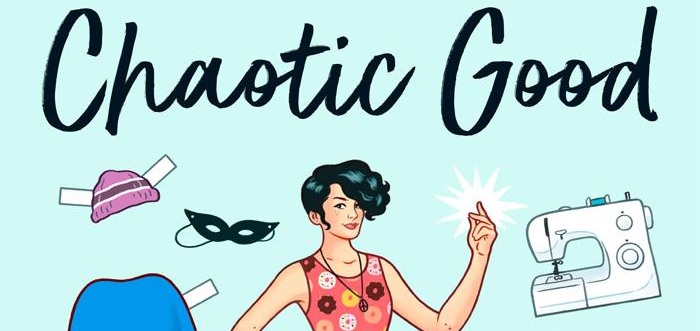
Chaotic Good
Author: Whitney Gardner
Genre: Young Adult
Publisher: Knopf
A Review by CL Vitek
 It’s the summer before senior year and Cameron isn’t starting it off great. Her family moves to a new town. Her college applications aren’t finished. And she’s inadvertently set off an internet firestorm of abuse and harassment from angry male fans after winning a cosplay competition. To make matters worse, the only comic book store in her new town is staffed by an unfriendly owner who makes her feel unwelcome and challenges any woman who visits.
It’s the summer before senior year and Cameron isn’t starting it off great. Her family moves to a new town. Her college applications aren’t finished. And she’s inadvertently set off an internet firestorm of abuse and harassment from angry male fans after winning a cosplay competition. To make matters worse, the only comic book store in her new town is staffed by an unfriendly owner who makes her feel unwelcome and challenges any woman who visits.
With her costuming experience and twin brother’s help, Cameron borrows clothing and pretends to be a boy to make a point. She is not only welcomed into this mostly male space but also invited to play D&D with them, dragging her brother along in the process. As her plan gets more complicated, she finds herself making friends in unexpected places, her costume portfolio stalls in creative roadblock, and amid romantic misunderstandings she’s got a crush she isn’t sure how to handle.
Chaotic Good, Whitney Gardner’s follow-up to You’re Welcome, Universe, is an exploration of fandom, high school, and internet infamy. Let’s start with why I think this book and books like it are important. There’s been a lot of conversation around women and fandom. Discussing gatekeeping in fandom spaces isn’t new or unique to the plot of this book. What is new is a story that confronts harassment in cosplay and on the internet. We see how abuse that comes from anonymity of the internet can have lasting consequences.
Being a girl in a boy’s space is hard, especially when you’re a teenager. I’m speaking from experience. I’ve attended conventions since I was in my teens and involved in costuming for over a decade (Yes, I’ve actually made a Dazzler costume, though not the one featured on the cover in this case). The book touches on a lot of issues confronting geek culture and how girls navigate a scene historically seen as boys-only. It’s a good time for fiction from the geek girl’s point of view, as so many good books have featured the geek guy. Because of this, I really wanted to love Chaotic Good. I ended up leaving with mixed feelings.
Cameron is shamed in a way that many girls in geek culture know well; she’s accused of being a “fake geek girl.” It’s a relatable experience in the comics and gaming world; it also comes with associated stigma that can be frustrating and alienating for someone exploring their interests. The book doesn’t hold back from showing how toxic that can be and Cameron struggles with how to handle that negative attention. Chaotic Good also shows that even good guys can ignore or shrug off problematic behavior from people they care about, making it harder for others to speak up about it.
Cameron’s love interest is a highlight of the book. He’s a larger guy and that’s immediately part of why she’s attracted to him. It’s not something she (or he) had to overcome. It’s really nice to see that. I also enjoyed the way consent was handled. Lincoln and Cameron are open about how comfortable they are with being physical. This is shown as a positive and attractive thing.
When the book touches on roleplaying and D&D, it’s a lot of fun. It was a good way for Cameron to grow closer to the other characters and highlights some of their personalities in the way they approached the game. Throughout those scenes, there were short comics that went through some of their D&D campaign. The illustrations are a nice touch, marking the shift between what’s happening in the real world and the events going on in game. I really only wish we’d had more of them!
As for the cast, there are some prominent gay characters, even if their stories are secondary in the narrative. It’s still a decent nod to how fandom spaces are not always exclusive to a certain type of people. This also plays into some of the aspects of Chaotic Good that I didn’t find as compelling.
Gender plays a big part in the book and tied to Cameron’s feminist thought. Unfortunately, it’s not intersectional feminism. Cameron dresses as a boy essentially as a prank. She is trying to prove something to the guys at her local comic book store. With a modern setting and LGBT characters, you’d think the plot might include something about genderfluidity, trans* communities, or nonbinary people. The book doesn’t really acknowledge their existence. It also ignores that the exclusion can perpetuate dangerous stereotypes. Namely, gender expression that doesn’t match gender assigned at birth is often seen (falsely) as ‘deception’ in some situations. This stereotype can cause people real harm. With her brother’s repeated insistence she stop lying, there’s opportunity to mention some of those problems, even if only in passing.
This story relies so heavily on a lot of stereotypical male nerd behavior that it manages to erase other women from the narrative almost entirely. Cameron’s female friends only appear briefly and their support in the situation feels sidelined compared to the time given to the male characters and her relationships with them. I wish there had been more girls in Cameron’s journey through geek girl culture.
With Cameron’s friends such a defining aspect of her big conflict (the internet harassment), it was disappointing not to see them until really late in the book. The same is true about the source of her internet infamy: cosplay. The representation of costuming in this book didn’t resonate with me the way I hoped. It didn’t feel genuine in any relatable way. I’m not sure how many people would commission a several hundred dollar costume from a teen prodigy and be happy to receive pieces taken out of a thrift store bin with a fabric-paint stenciled t-shirt. As said teenager has the kind of budget to buy new comics and graphic novels then rip them apart for “reference material”, I don’t know that Cameron’s insistence she is ‘just that thorough’ with her creations holds a lot of weight.
Lastly, the pop culture references were distracting. Within the first seventeen pages, I counted six specific fictional characters and celebrities from other franchises name dropped. I don’t know that real world popular culture added to the story any more than fictional films and characters would have. It might have been easier to handle a few distinct (and original) references than another genderbent version of a popular video game character sparking death threats on the internet.
Verdict:
In the end, I like Cameron more than I liked her story. The heart of Chaotic Good is great: girls shouldn’t have anything to prove in fandom spaces. The book and its cover give the impression that cosplay and comic conventions are going to dominate the storyline. They don’t. The book is really more about gaming and internet culture. I wish the cosplay culture aspect was either better represented or not as much of a focus. The part of the story centered on Cameron’s new interest in tabletop gaming is more interesting than her costume designing dreams.
Chaotic Good falls in the vein of Geekerella or Queens of Geek. Unlike those, it follows the story of lone female MC than the female friendships often discovered in geek spaces. It’s a cute, standard young adult romance with a geek dressing. While it definitely will appeal to gamers and girls navigating fandom for the first time, the reliance on pop culture references and heavy use of stereotypes and tropes might turn some readers off.
Chaotic Good is available in bookstores now.

![[PODCAST] FANBOY POWER HOUR EPISODE 280: YOU HAD ME AT BAT-CASTLE](https://geekd-out.com/wp-content/uploads/2020/01/Fanboy-Banner-150x150.jpg)
![[PODCAST] THE COMICS AGENDA: THE MOST HEART-POUNDING, PULSE-STOPPING, EXHILARATING EPISODE EVER](https://geekd-out.com/wp-content/uploads/2017/11/comics-agenda-2-150x150.jpg)
